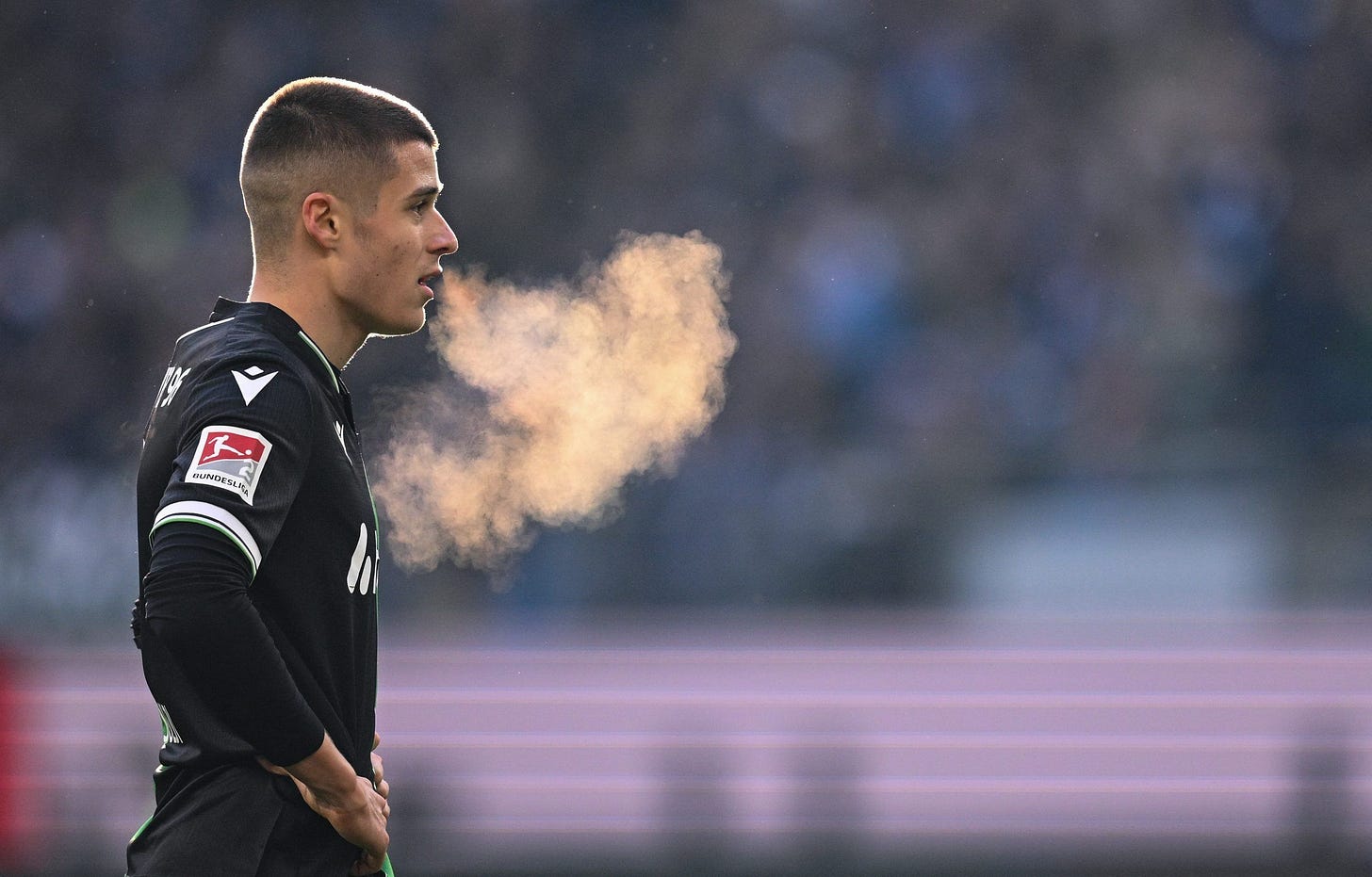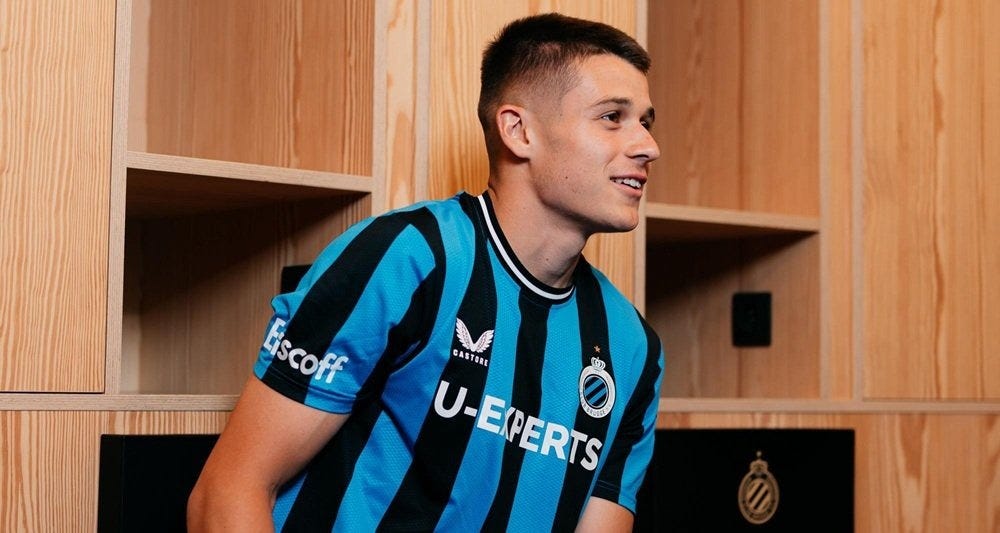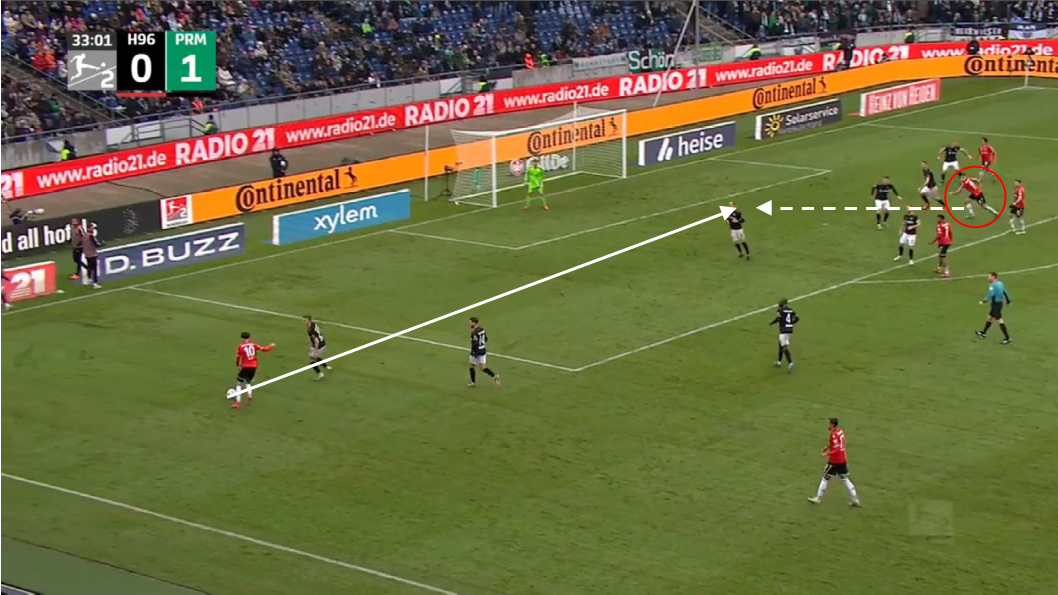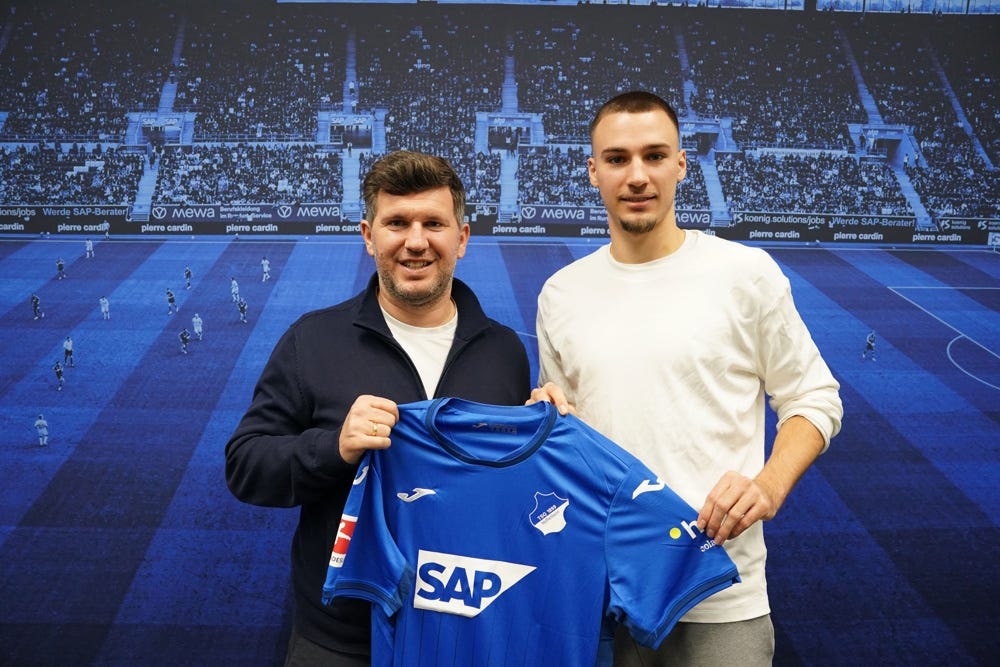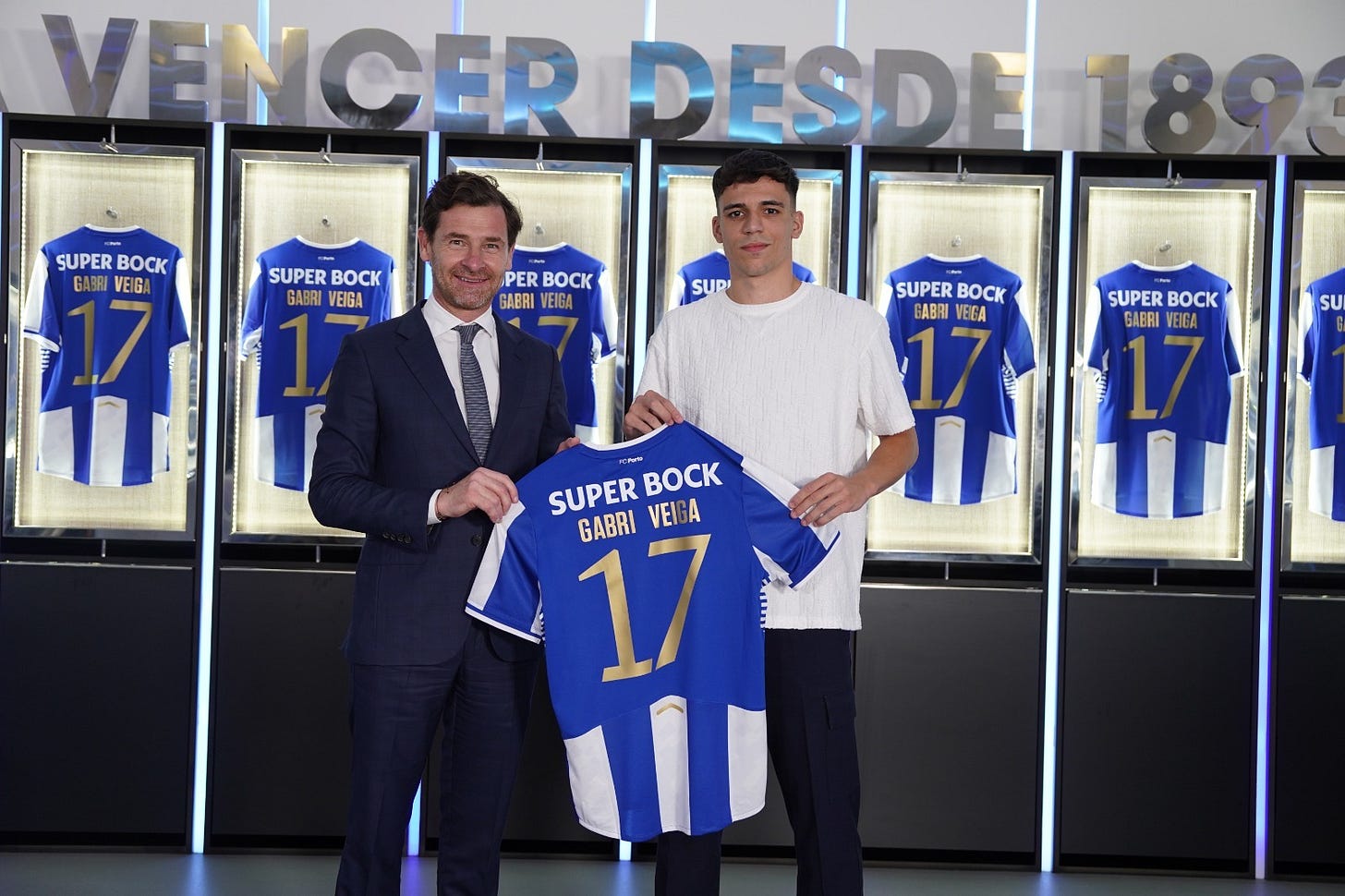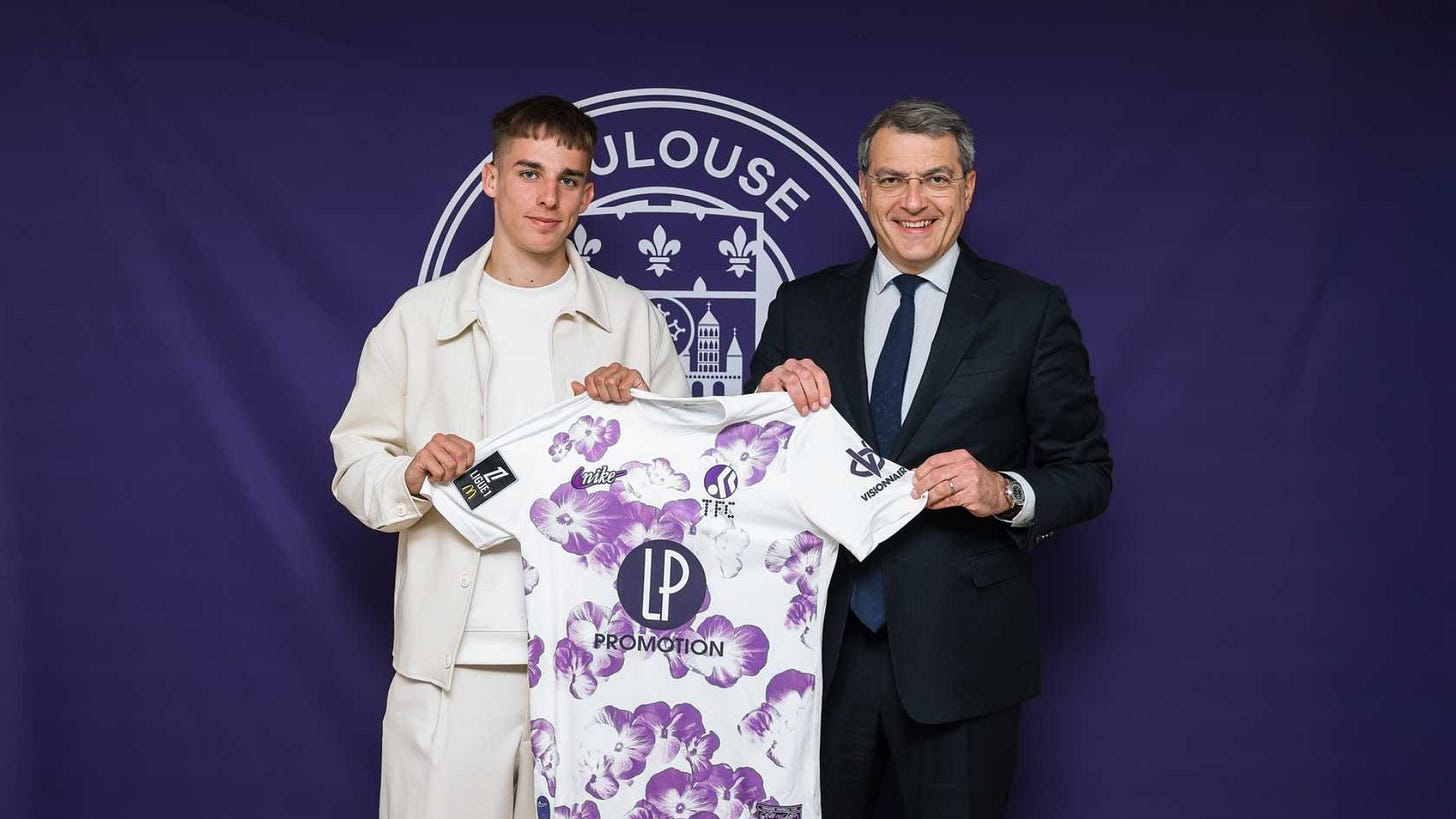Three under-the-radar signings that you and I might have missed (Part 2)
A current Germany U21 hotshot, another German leading the line to a promotion, a forgotten wonderkid, and a truly under-the-radar honourable mention.
As the first summer window came to a close, many clubs have opted to begin their transfer business early as they either secured their long-term targets or took advantage of opportunities that came up within the past 10 days. In the end, the frantic nature of the summer window was on full showcase, especially for clubs who will be playing in the Club World Cup in a few days time (at the time of writing). This will only set the tone for what is to come during the actual window that will be open on July 1st or June 16th for English and French clubs.
Amongst the however-many-there-were transfers that happened within that 10 days, there were ones who received a lot of attention due to their transfer fee, ability, or everything that was around the move itself. There were also many transfers that were very interesting, but went under the radar or did not receive the attention that it deserved. And that is the main purpose of this series, as I continue to highlight three (or four) more signings that you and I might have missed because they were not on the front page of many publications.
Without further ado, let’s get into the three signings for this edition of the series!
Note: All stats and data used in this article are from Opta via Fotmob and FBRef unless stated otherwise.
Nicolò Tresoldi
(Hannover 96 → Club Brugge)
The 2. Bundesliga seems to be one of the best leagues currently when it comes to developing young and promising strikers. While Stefanos Tzimas had stolen the spotlight last season for his performance at Nürnberg that earned him a big move to Brighton, there are plenty of other names that also deserve the attention, including Elversberg loanee Fisnik Asllani, Hamburg’s Ransford-Yeboah Königsdörfer, or Köln’s Damion Downs.
However, it will be unfair if we somehow do not include Hannover’s Nicolò Tresoldi on that list of up-and-coming strikers who have graced the grass of the 2. Bundesliga last season. Also another Football Manager wonderkid like Ísak Bergmann Jóhannesson from the first edition, Tresoldi’s performance with Hannover since he made the step up to the first team had left him out of the conversation for a big move outside of Germany or maybe even making the step up to the Bundesliga in the near future. But it is also worth remembering that Tresoldi will not turn 21 until August, and in the last two seasons with perenially-mid table Hannover, he still scored 7 goals in each season.
On the grand scheme of the Torjägerkanone (top scorer) race, 7 goals was not a lot and did not even put him close to Jóhannesson, who scored 11 goals in the 2024-25 season. But it still showed that Tresoldi did leave behind his disappointing, goalless 2022-23 season to provide a consistent performance during the two season afterwards, and he was able to adapt to the league quickly while he was still under 21 by the way.
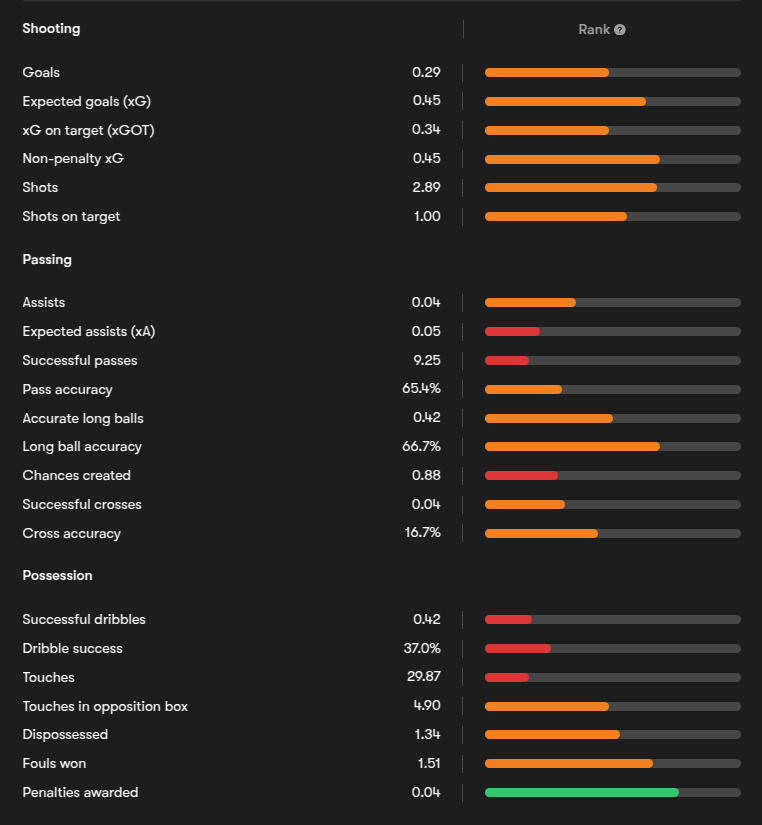
With 2151 total minutes played last season, Tresoldi had the sixth-most amount of minutes played for Hannover last season, behind goalkeeper Ron-Robert Zieler, one-to-watch midfielder Enzo Leopold, and a group of defenders that included Marcel Halstenberg, Phil Neumann, and Sei Muroya. Even Hannover’s other striker options like Jessic Ngankam, Håvard Nielsen, or Andreas Voglsammer did not come close to cracking the 2000 minutes played mark, which showed the club’s trust in their most promising talent.
Again, Tresoldi’s numbers and percentile ranks from last season were not that impressive. But you also have to take into account the fact that Tresoldi and Hannover experienced managerial inconsistency last season with Stefan Leitl got sacked in December, only for André Breitenreiter to come in and then also received the marching order in April, as the club finished the season with three co-interim coaches, it meant that Tresoldi had to adapt to three different style of play while also had to maintain his consistency as the team’s starting striker.
However, from his percentile ranks, it is still possible to make out the striker profile that Tresoldi was for Hannover. In an era where most teams seem to have favoured a traditional #9 (tall, quick, a two-way striker) to lead the line, Tresoldi presents himself as a goal poacher who utilises his pace and off-ball runs to make up for his height disadvantage. He did not dribble with the ball very often (0.42 dribbles per 90), nor was he good at doing so (37% dribble success rate). He was also not very good at creating chances for others as well, having only created 0.88 chances per 90, putting him among the bottom 30% when comparing against other 2. Bundesliga strikers.
What he excels at, however, from looking at the goals that Tresoldi scored for Hannover last season, is showing up at the right place inside of the penalty box to capitalise on errors or loose ball for a goal, and finding the space where he can receive the ball and create his magic from there. With the latter trait, his goal against Elversberg on matchday 12 showed exactly that as Tresoldi twice found himself in behind Elversberg’s midfielders, where there were spaces for him to receive the ball from Phil Neumann and Bartłomiej Wdowik respectively. On his second attempt, Tresoldi faked receiving the ball outside of the penalty box, which drew one of Elversberg’s defenders out of position and created space for Andreas Voglsammer to be the actual receiver of the pass. A flick-on later from Voglsammer and an off-ball run to attack the space to his left and Tresoldi found himself in a 1v1 situation with Elversberg’s keeper, which he did not miss.
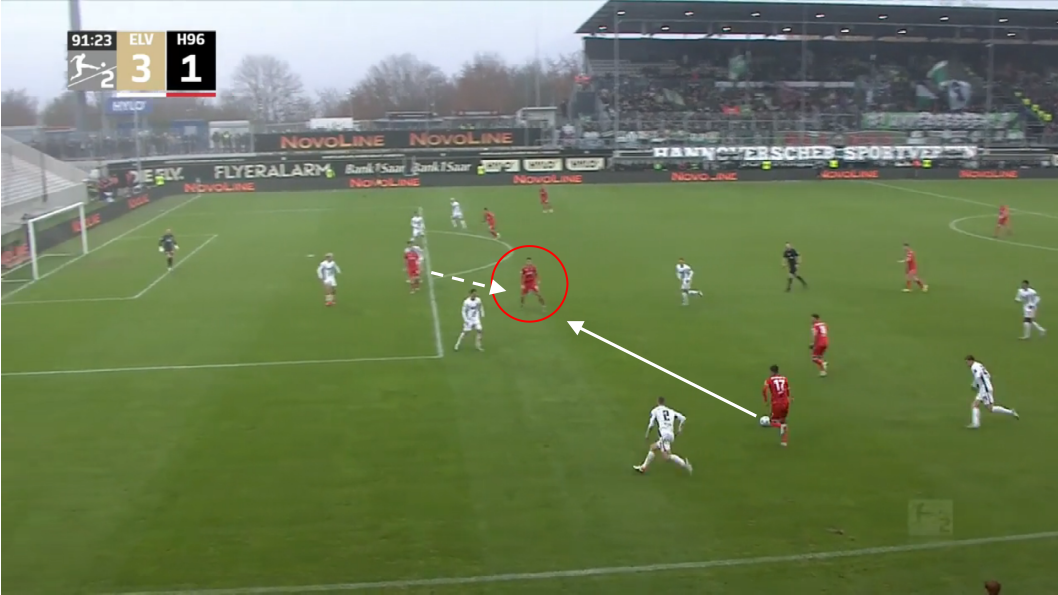
Tresoldi’s off-ball runs inside of the box seems to be one of his most dangerous weapons. Combining that with the fact that, despite the Italian-born striker’s height disadvantage (he only stands at 183cm, or just over 6 feet) compared to a traditional #9 that many big clubs are using, Tresoldi is very lethal in the air, and we have a very good ‘fox in the box’ striker profile. Another goal of his, this time against Münster on matchday 19, also demonstrated that quality. After taking a step back to move himself out of the opposition’s defender’s sight, Tresoldi timed his run very well to attack the space in behind Münster’s defence and arrive at the right time to head Jannik Rochelt’s cross into the goal.
Going back to the data, and once again ignoring the slightly underwhelming numbers and percentile ranks, Tresoldi did show some improvements from the 2023-24 season. The season before, the Germany U21 international made 3.45 shots per 90, with 32.9% of them found the target. Along with his non-penalty xG at 0.43 npxG per 90, that meant he registered 0.125 xG per shot, which was still a very decent rate. But the improvement came in the fact that Tresoldi took less shots this season (2.89 shots per 90), while the on target percentage increased to 35.3% and his npxG remained at a similar level (0.45 npxG per 90). It also meant that his xG per shot rate increased to 0.156 xG/shot, which is a slightly significant improvement. All of these numbers demonstrate that Tresoldi is choosing his opportunities more wisely and getting more composed in front of goal to find the best opportunity to score, instead of aimlessly making shots in hope to find a goal.
It is also worth considering the context that Hannover’s attack had a slight decline last season, as their overall xG dropped from 54.5 xG during the 2023-24 season to just 48.1 xG last season. It probably did not help the team that they got awarded a whopping 8 penalties the season before, while they only got awarded 3 penalties last season, which might have skewed their xG quite a bit. Other stats do not agree with that skewness, however, as their shot on target per match (4.9 from the 2023-24 season, and 4.1 from the 2024-25) and touches in penalty box (817 from the 2023-24, 831 from the 2024-25) both stayed on a relatively similar level. All of this to say that Tresoldi was doing everything to the best of his ability even during an inconsistent period for Hannover.
Another reason for me to believe that Tresoldi is a goal poacher/’fox in the box’ is his shot maps from both seasons when compared with each other. Of the 47 shots that Tresoldi had taken from open play during the 2023-24 season, the location where he tended to take his shots are in and around the 6-yard box with a few scattered on the right-hand side and inside of the 18-yard box. But when looking at Tresoldi’s 48 shots from open play from last season, it is very obvious to see that his tendency has shifted towards being central-focused as 90% of the 48 shots were taken straight down the middle of the 6-yard box and 18-yard box.
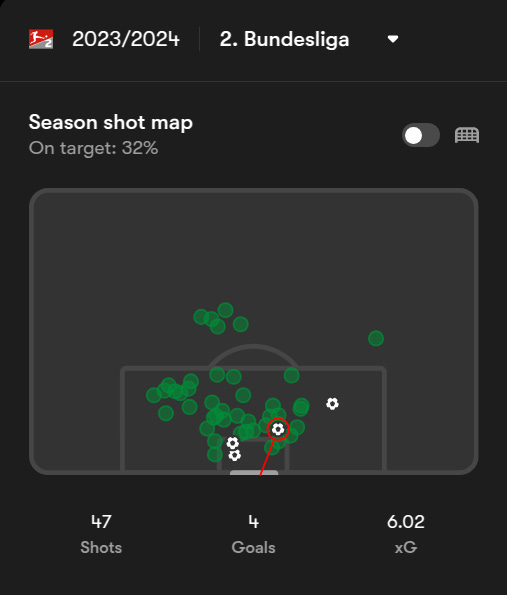
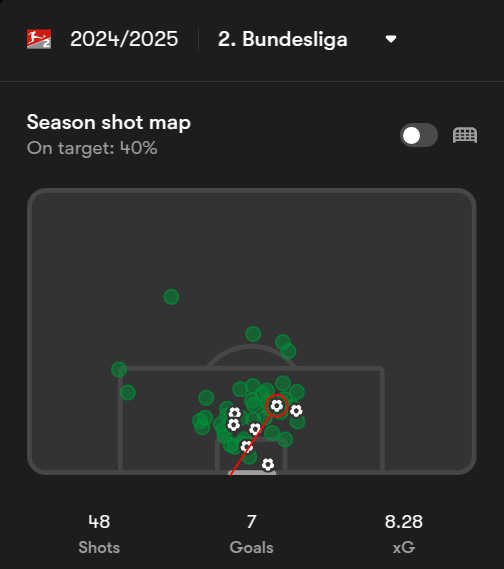
With a plethora of attacking options at Hannover’s disposal, including three attackers who can play centrally in Voglsammer, Nielsen, and Ngankam, losing Tresoldi might not be too big of a problem. But while all three have experienced a drop in their goal-scoring form last season, Tresoldi did not, so the club will have to somehow find a way to replicate that consistency in front of goal. Hannover will also welcome the return of Marius Wörl, who I really enjoyed watching during the two seasons that he played with Arminia Bielefeld, especially during last season’s DFB-Pokal run. Wörl has shown that he can also be a goalscorer from the left-hand side as he stepped up significantly this season to score 9 goals across all competitions, something that Hannover’s next manager (whoever that will be) will be glad to hear.
Meanwhile, a club’s lost is another club’s gain. Getting an U21 international for a reported €7million is a very good bargain for Club Brugge, who will be adding more attacking power to an already very prolific front line. The club have experienced success with bringing a 2. Bundesliga up to the top level and getting the best out of them before with Christos Tzolis from Düsseldorf being the prime example. Tresoldi will be walking into a team that will not be relying solely on him to score goals as Ferrán Jutglà and Gustaf Nilsson have had a fairly decent season with 10 and 9 goals respectively, which will relieve a bit of pressure on his shoulder and give him more time to adapt to a very competitive Belgian Pro League.
All things considered, this move feels like it is a sensible move for Tresoldi and Club Brugge. For Tresoldi, he will get a taste of a top division for the first time in his career, but the transition will not be too steep that might do more harm to his career than good. For Club Brugge, they are getting a high potential striker who can step up to replace Jutglà and Nilsson should they receive an offer for either in the near future, and who might yield them a big return in the future should they help and guide his development on the right track.
Update (as of June 25th)!
Tim Lemperle
(1. FC Köln → TSG Hoffenheim)
On that same list that Tresoldi and Damion Downs were on, we will also find Tim Lemperle, who finished last season as Köln’s joint-top-scorer with Downs with 10 goals to his name. Together, they fired Köln to a seemingly unexpected 2. Bundesliga title that Hamburg should have had it in their hands on so many occasions if not for their yearly tradition of bottling every chance of success. What was more impressive about Köln’s achievement was they won the league with a young core of player that included the striker duo of Downs and Lemperle, their compatriot Jan Thielmann, but also midfielders Eric Martel and Denis Huseinbašić that I have mentioned in the last edition, and defenders Julian Pauli and Max Finkgräfe. A wonderkid wonderland, some might say.
Lemperle actually endured two tough seasons with Köln in the Bundesliga as he struggled to make an impact during a period when they were yo-yoing between the 2. Bundesliga and, somehow, challenging for a European spot. A loan move to Greuther Fürth seemed to have done the trick with Lemperle unlocked his goalscoring ability and finished the 2023-24 season with 6 goals and 6 assists in Germany’s second division. That turned out to be a great preparation for him to return to Köln when the club was sent back down to the 2. Bundesliga, which opened up the chance for Lemperle to take the starting striker spot. Managerial inconsistency aside (which seems to just be the theme for almost every 2. Bundesliga club that we have talked about), Lemperle took that opportunity and made the spot his by racking up 1790 total minutes played last season, just 2 minutes behind his teammate Downs, and completely blocked Köln’s other attacking options like Imad Rondić, Steffen Tigges, Sargis Adamyan, Mark Uth, and Florian Dietz out of the starting lineup.
Similar to Tresoldi, Lemperle can be seen as somewhat of a ‘goal hunter’ whose presence inside of the penalty box can cause a lot of problems for the opposition. This is highlighted by his 7.30 touches in the opposition’s penalty box per 90, putting him amongst the top 20% 2. Bundesliga strikers on this metric. But in contrast to Tresoldi, Lemperle is 6cm taller as he stands at 186cm (just over 6’1”), yet that still did not put him among the tallest strikers at Köln.
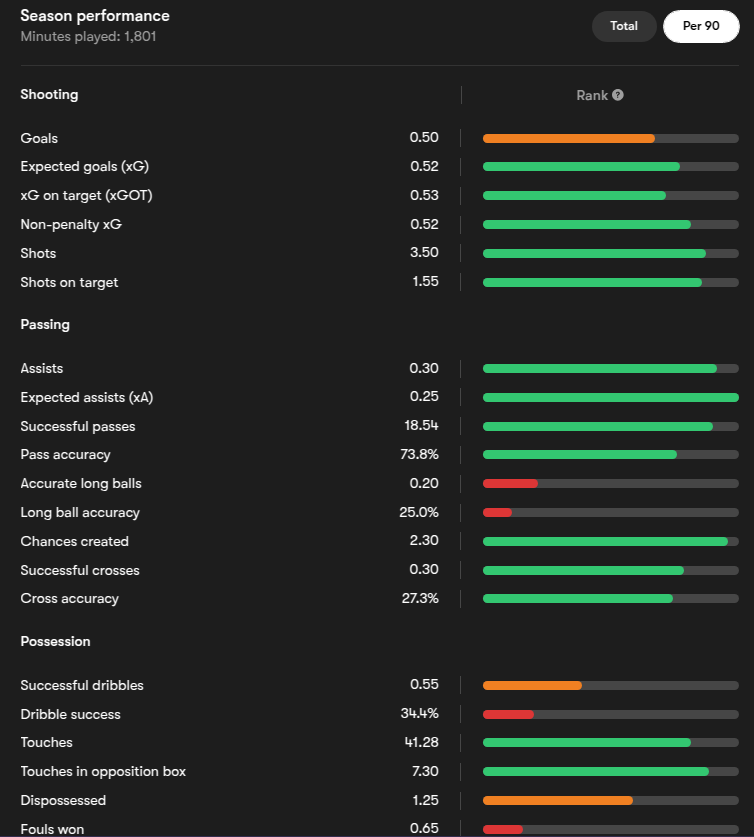
When watching his goals from last season, Lemperle came across as a rangy striker, who is slightly tall, but also quick, and very strong both on- and off-the-ball. A shared characteristic across most of the goals that he scored was his trait combination of staying high to pin the opposition’s defenders deeper, then wait for a through ball from a teammate, then make an off-ball run into the box and in the same direction of the through ball to pick it up in a good position to score. Lemperle had both the pace and the strength to outrun and outmuscle the opposition’s defender, which makes for a fascinating view.
His goal against Hannover on matchday 14 highlighted basically everything that I have said above. When Köln had possession inside of the middle third, Lemperle dropped slightly deeper and dragged Hannover’s defender Josh Knight out of his position, which created space in behind for a soon off-ball run. Once the team managed to get the ball into the final third by passing the ball to the left winger who progressed into the final third, Lemperle picked up his pace and ran into the space that he created for himself, forcing Knight to catch up with him. The former Peterborough United centre-back then found himself in a 1v1 situation with Lemperle, and subsequently got outmuscled and pushed over very easily, leaving Lemperle in another 1v1 situation with goalkeeper Ron-Robert Zieler, where Lemperle calmly slotted it home. All of that happened within the space of 10 seconds…
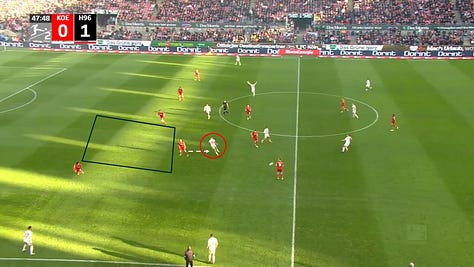
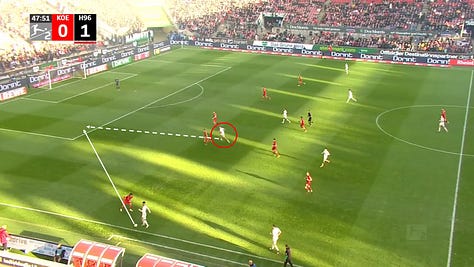
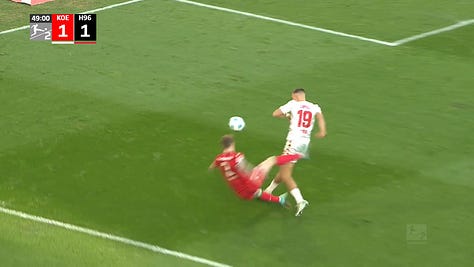
He is not just good at creating spaces, but also utilising spaces at his disposal, which proved to be quite crucial for Köln during counter-attacking situations. Lemperle tended to attack the channel between a centre-back and a full-back if they stood diagonally to each other instead of being on the same line. He also has the game intelligence to make the spaces bigger for himself by making out-and-in runs to distance himself from the opposition’s defender and pick up the through ball, cutback, or low cross from one of his teammates.
This might be a weird and strange comparison, but from watching the goals that Lemperle scored last season, he reminded me of Leipzig’s Benjamin Šeško, who is also a rangy striker, a tall, quick, and strong both on- and off-the ball type of striker. It could be because of his running pose and the use of his leg span to help him run quicker and further for each step that he took.
The eye observation suggests that Lemperle is a good goalscorer because of his on-field traits that give him the advantage over the opposition’s defenders, and the data also seem to agree. Lemperle is one of the most active and prolific strikers in the league as he made a very high number of shots (3.5 shots per 90s), but also managed to get 43.5% of such shots on target, which is a high percentage on the grand scheme of things. What is more noticeable is that Lemperle did not overperform his expected numbers (0.5 goals scored from 0.52 non-penalty xG per 90s), in fact, he even underperformed by 0.02 goals. These numbers highlight that even though Lemperle is still an unfinished product, his quality as a goalscorer was nothing short of spectacular for Köln.
Another aspect that made Lemperle stood out compared to other 2. Bundesliga strikers was his ability to create chances for his teammates. 6 assists in a season is already an impressive number, but the fact that he was also ranked among the top strikers in the league for expected assists (0.25) and chances created (2.3) per 90s is even more surprising. Far from being a lethal goalscorer, this means Lemperle can fit into the role of a two-way striker, someone who is dangerous inside of the penalty box when presented with goal-scoring opportunities, but also outside of it by his ability to put teammates into good positions to score.
Those attributes still do not complete the package that Lemperle will bring to Hoffenheim, however, as Die Kraichgauer will also receive a striker who is willing to work hard off-the-ball for the team. Last season, Lemperle registered 3.75 recoveries per 90s and won possession inside of the final third 1.1 times, still putting him as one of the top 2. Bundesliga strikers in both metrics. He did not get stuck into tackles that often, but rather used his positioning and strength to be at the right place to intercept passes or challenge the opposition’s defender to regain possession for his team.
With everything about Lemperle that I have analysed above, it is outrageous to know that Köln are losing a very promising and good striker to Hoffenheim on a free! Lukas Kwasniok still has the service of Downs to replace Lemperle’s goalscoring ability and Gian-Luca Waldschmidt and Florian Kainz to replace his chance creation, while Lemperle’s departure will also make way for Rondić and Tigges to play more often. But still, Köln’s higher-ups must have beaten themselves up for not securing Lemperle on a new contract or, at least, retrieving some kind of a transfer fee for his quality.
Meanwhile, Lemperle will be playing under the guidance of a manager who has slowly developed a reputation for getting the best out of young strikers in Christian Ilzer. At Sturm Graz, he turned the likes of Kelvin Yeboah, Emanuel Emegha, and a certain Rasmus Højlund into top quality strikers. Next season, Ilzer and Hoffenheim will have at their disposal four very promising and exciting strikers in Lemperle, Adam Hložek, Gift Orban, and returnee Fisnik Asllani, who finished last season as the third-best goalscorer in the 2. Bundesliga for Elversberg with 19 goals across the regular season and the playoff. And that’s not mentioning Max Moerstedt and Bazoumana Touré, who are both still 19 years old at the time of writing. If, and that’s a slightly big ‘if’ with the recent rumours and interests surrounding Asllani, they can retain all of the names listed above, Hoffenheim will have a very exciting front line to watch. The biggest question, however, will be, how can Ilzer come up with a system that can get the best out of everyone and give everyone an equal playing time?
Gabri Veiga
(Al Ahli → FC Porto)
It was only three seasons ago when Gabri Veiga lit up the La Liga with his performance for Celta Vigo, prompted many big clubs to pay attention and enquired about his service. A move to Napoli was thought to be very close to completion, yet an unexpected twist came during the summer window when a cash-loaded Al Ahli came swooping in to activate his €40million release clause. Getting guidance under one of the most talented young managers at the moment, Matthias Jaissle, was not a bad experience for Veiga, but the move to the Saudi Pro League felt like a step down from playing at a top-level league like the La Liga.
Two seasons and an AFC Champions League Elite title later, and the name Gabri Veiga will appear once again at a European club. Instead of heading back to Spain, Veiga will be FC Porto-bound as André Villas-Boas and the club’s higher-ups have opened their pocket to secure Veiga’s signing from Al Ahli for a bargain price of €15million, less than half of what many big clubs would have had to pay a couple of summer windows ago. And yes, you’re not seeing the image wrong, that’s Villas-Boas, the club’s president (and not their manager), holding Veiga’s shirt to unveil the player.
Veiga was decent among a star-studded Al Ahli side, but you would expect to see more from a promising midfielder like him, particularly more than just 12 goals and 10 assists across all competitions during the two seasons that he played in Saudi Arabia. I can understand a bit for the slightly low outputs as he had to compete with the likes of Roberto Firmino, Ivan Toney, Galeno, and Franck Kessié, who were all better than him and would have demanded more of the ball.
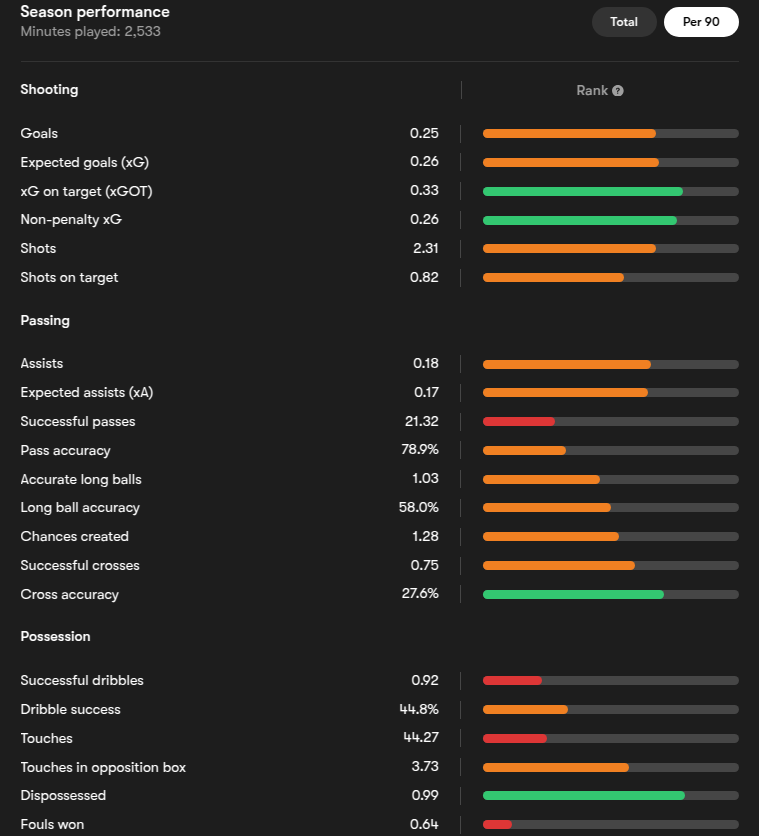
His per 90 stats and percentile ranks from last season still showed Veiga’s quality that many Celta Vigo fans still remember, but at a slightly lower rate. He was still a goal-scoring midfielder for Jaissle’s side with 0.25 goals scored per 90s from 0.26 non-penalty xG per 90s as his goal-scoring numbers regressed back to the mean after two seasons of overperforming. Porto and Martín Anselmi will be glad to hear this as they will not have to rely too heavily on Samu Aghehowa and Rodrigo Mora for goals next season, who scored a combined total of 29 goals, which was 44.6% of Porto’s goal last season.
Veiga’s chance creating ability will also relieve a bit of pressure on Rodrigo Mora and ease the loss of Fábio Vieira, who will be returning to Arsenal after the Club World Cup. The Spanish midfielder will provide a solid option as one of the two #8s in the middle of the pitch or as one of the two attacking midfielders to the side of Samu, who will lead the line for the Portuguese side. Should he play as one of the two #8s, Veiga will receive some defensive help from the Canadian international Stephen Eustáquio even though he can also contribute to the defensive side himself, he just will not be very active in getting involved in challenges that often.
However, it is more likely that he will be playing as one of the two attacking midfielders who will be operating inside the half spaces and out wide. On that end, his ball carrying ability will be a massive help, and something that he did not get to do much during his time in Saudi Arabia. During the 2022-23 season when he lit up the La Liga, his dribbling percentile ranks as shown below were all above the 60th percentile rank, putting him among the top 30% of attacking midfielders in the Spanish top division.
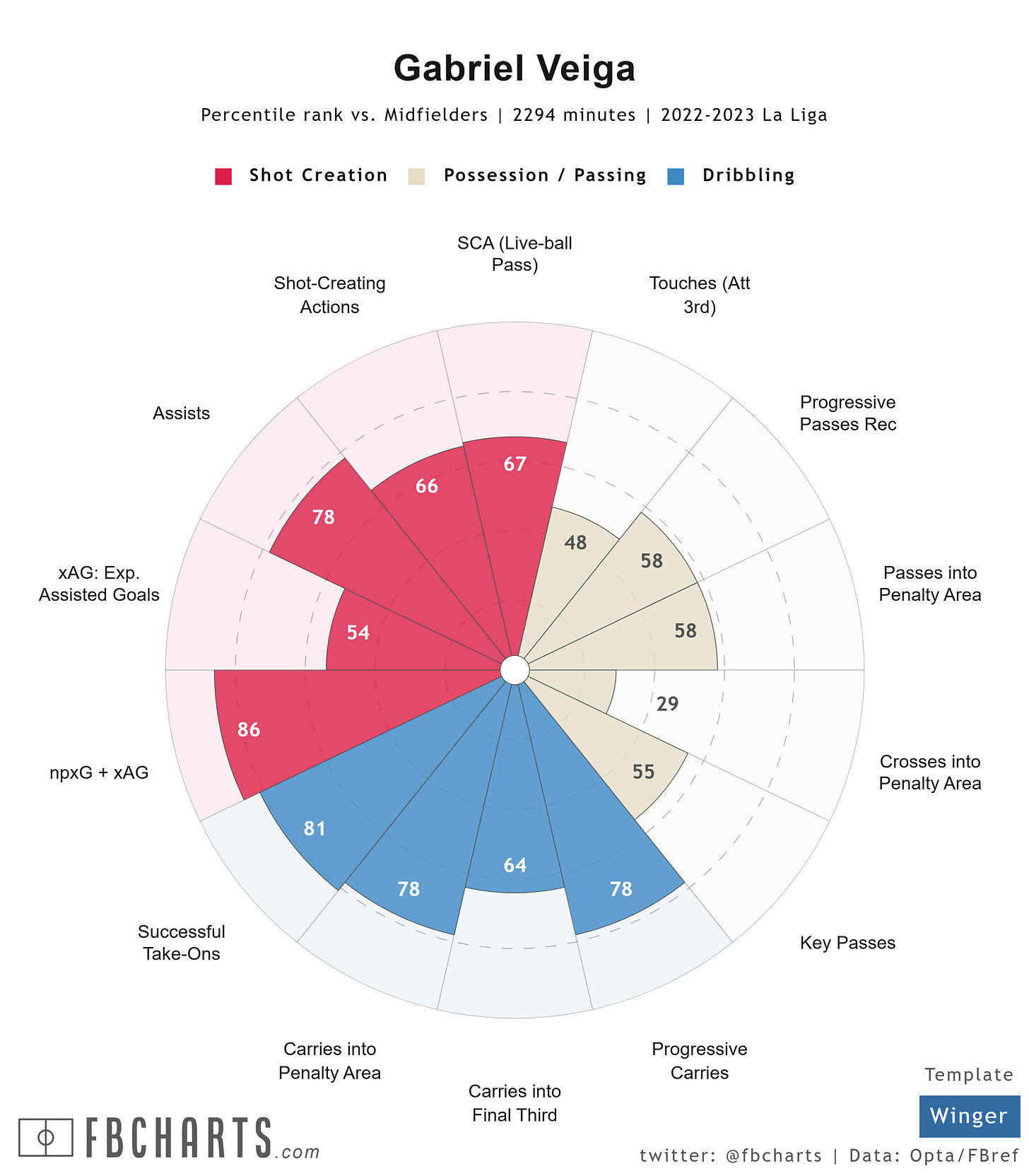
Since moving to Saudi Arabia, Veiga has developed into a more complete package while also adding chance creation to that skillset portfolio of his. Saying that the move to Al Ahli did not help him is probably a wrong statement to make, but his development has slowed down a bit as the quality of the league dropped and the amount of game time also dropped.
But it is worth to remember that Veiga is still 23 years old at the time of writing and also at the time of his move back to Europe with Porto. He will be joining a team that are slowly falling behind their fiercest rivals Sporting CP and Benfica as financial difficulties and a few years of bad decision-making have set the club back for quite a bit. They are still a very prolific youth academy and still probably one of the best in Europe on that regard, with Rodrigo Mora being their latest example of a potential wonderkid. As such, Veiga will be surrounded by a group of young and promising players who will be playing at a very high level in both Portugal and in Europe, and especially as they will be one of Portugal’s two representatives at the upcoming Club World Cup.
Honourable mention: Mário Sauer
(MŠK Žilina → Toulouse FC)
This will be a quick, but short honourable mention as I do not have enough data to make any observations nor enough footage to analyse. But whenever Toulouse make a signing, it is always worth taking a closer look as they are one of the best clubs when it comes to using data in recruitment thanks to a partnership with Zelus Analytics, or Teamworks Intelligence as they are known nowadays.
Toulouse’s first foray into this summer window, and potentially Damien Comolli’s last signing for the club before he left to join Juventus, was to bring in young Slovakian midfielder Mário Sauer from MŠK Žilina. As the lesser-known Sauer in the current Slovakia U21 squad at the U21 Euro, behind Feyenoord’s Leo Sauer, Mário is a central midfielder who can provide a bit of flexibility to Toulouse’s squad as he can also occupy the defensive midfielder and left winger spots.
His records of 7 goals scored - 6 assists from last season and 6 goals scored - 6 assists from the 2023-24 season suggest to me that he is an offensive-minded midfielder who can crash the box with his dribbles to create chances for himself and others to score. At 21 years old, I am quite intrigued to see what he can do at a higher level with Toulouse and Ligue 1, a league that has been known in recent seasons for nurturing and developing young talents.
Because there is not enough data and my knowledge of the Slovakian league is absolutely none, I will leave you in the hands of Target Scouting and Philipp Hollenhorst, who will analyse Sauer’s style of play in greater details.
The first transfer window had come and gone in a flash while carried with it the franticness of a usual summer window. Many teams still show the tendency of targeting younger and younger players after each window as they try to build towards a long-term future instead of aiming for short-term successes. But this was nothing less of a curtain raiser for the main transfer window that will be opened in a few weeks’ time, or maybe even a few days’ time for many English and French clubs.
Once the main window opens, you can expect me to show up once more, going through a list of recent transfers, and highlight the ones that you and I might have missed. Until then, ciao!


